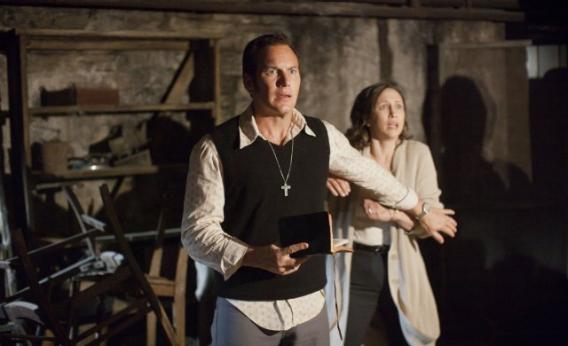How the “Hurdy Gurdy Man” Got Creepy

Still from The Conjuring © Warner Bros. 2013
The terrifying new trailer for The Conjuring, the new horror movie from Saw director James Wan, makes use of the usual horror movie tropes when it comes to music. There’s lots of silence, then sudden stabs of discordance whenever a demon jumps out. But there’s one exception to its straightforward approach: The use of “Hurdy Gurdy Man,” a bit of ’60s psychedelic pop from British folk singer Donovan.
The effect is creepy, but not entirely surprising: Anyone who’s seen David Fincher’s Zodiac, in which the song is associated with the titular real-life serial killer, probably can’t listen to the song without a tingle shooting down their spine. Did Zodiac transform “The Hurdy Gurdy Man,” or was he creepy all along?
It may be hard to imagine now, but there was in fact a time when most listeners thought the “Hurdy Gurdy Man” sounded like a pretty nice dude. After all, he’s just a short and plump little guy (a “roly poly man”) who plays a quaint centuries-old instrument (the hurdy gurdy), “singing songs of love.” And there’s hardly anyone less sinister than Donovan, a flower child famous for such sunny, ad-friendly hits as “Mellow Yellow” and “Sunshine Superman.” Donovan even said “Hurdy Gurdy Man” was about the Maharishi, whom he studied under alongside the Beatles. (He wrote the song before many in their circle soured on the guru, resulting in John Lennon’s “Sexy Sadie” a few months later.) Donovan even felt positive enough about the “Hurdy Gurdy Man” that, for the subtitle of his 2007 autobiography, he used the name to describe himself.
Early cover versions tended similarly to focus on the song’s sunny side. Take for example, Steve Hillage, who recorded the song in 1976. In this filmed, live performance you can see how he smiles through just about the whole song, while the audience claps along.
But the song’s odd production—Donovan sounds like he’s singing through a fan—and downbeat performance did make some uneasy. While typically described as a “sixties period-piece ditty” “about the power of music,” the 2002 All Music Guide to Rock calls it “dim, dark.” Even the video for “Hurdy Gurdy Man,” if you watch closely, plays troubadours and hippies dancing in bikinis against, at one point, an atomic explosion.
For their 1991 version, the Butthole Surfers took a more silly approach—the cover even appeared on the soundtrack for Dumb & Dumber—and the video saw them goofing around wearing wigs and dog masks and playing with puppets, but the trip turns bad at the end. The puppet gets torched.
In Sleepers (1996), that ambivalence, perhaps rooted in the notoriously violent summer in which the song was released, comes to the forefront. Sleepers uses the song to soundtrack a montage of Vietnam on TV and spousal abuse at home.
L.I.E. (2001) used the song to soundtrack Big John (Brian Cox) prowling the streets looking to seduce adolescent boys, years before Zodiac associated the song with the predations of the Zodiac Killer. The fact that the hurdy gurdy is such an obscure instrument means that for many viewers “Hurdy Gurdy Man” could refer to just about anyone.
Bobby (2006) uses the song once again to convey both the joys and anxieties of tripping on acid. As Ashton Kutcher’s Fisher explains, referring to LSD: “She can be beautiful. She can be terrifying.”
Even in the Robin Williams-starring comedy Man of the Year (also 2006), the song is used to surpringly dramatic effect, hailing the arrival of Williams’ jokester candidate at the same time as underlining his feelings of disorientation.
With Zodiac, Fincher didn’t dramatically repurpose the song so much as he brought this slow-moving trend to its natural conclusion, using the song to at once express the violence of the late ’60s and the sense that bad men are on the prowl. From there it’s no leap for The Conjuring (2013) to associate it with full-blown horror, completing the transformation of the “Hurdy Gurdy Man” into the Boogie Man.

